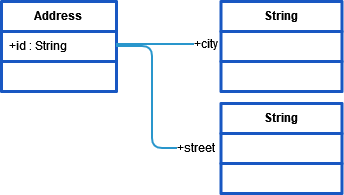The action script below creates an object of type Address. An output object named myAddress of type Address needs to be defined.
create myAddress;
set myAddress = addressAsXMLDocument.xmlToClass(); |
Beneath, a sample XML document is shown to illustrate the executed mapping. The XML document is mapped to an instance of Address as shown in the class diagram.
| XML Source | Target Class Structure |
|---|
<myAddress id="myAddressID">
<street>108, Kearny Avenue</street>
<city>Newark</city>
</myAddress> |  |
Note, that the XML element
myAddress is mapped to the object
myAddress, which is of type
Address. This type has the UML attribute
id which corresponds to the XML attribute
id. Additionally, the XML elements
street and
city are mapped to the association ends
city respectively
street. Both are having the type
String.
